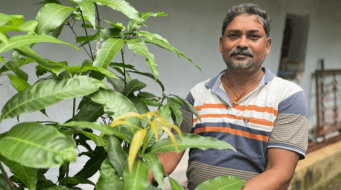-Arjuna Srinidhi and Arpan Golecha
2017 has been a year of weather aberrations in India – from droughts to heat waves and floods. After 2016, this year is said to have been the hottest year since temperature records were kept. The costs of adapting to a warmer world and one that is getting more unpredictable is only going to get higher. It would therefore, be more prudent to attach a high premium to immediate steps towards adaptation. However, the caveat remains that the investment in adaptive measures rely on shaky grounds in terms of data and have thereby remained insubstantial.
While estimates do exist for the costs of adaptation at a global level – $200 billion to $500 billion per year, there are few studies that provide bottom-up costs of adaptation. These costs of course depend on the local context, interventions being planned, eco-system, biodiversity etc, but nevertheless we felt that such bottom-up adaptation costs can be used as a ball-park figure for eco-system based adaptation planning in semi-arid regions. The Climate Change Adaptation project by Watershed Organisation Trust (WOTR) has been carried out in several semi-arid regions. One such region is the Sangamner Taluka in Ahmednagar district. We start our bottom-up study at a small village in the Western Ghats named Bhojdari.
Semi-arid regions have problems of water scarcity, droughts even floods due to climate variability, but high rainfall areas with ample water bodies are prone to frequent floods and arid regions have scanty rainfall and face water shortages all year round. The point of stating these issues is that adaptation has a different meaning for different types of regions.Thus, the costs of adaptation will differ as well. Areas prone to climatic disasters will require higher investments towards adaptation than the figures in this blog and vice versa. The idea of putting a small village like Bhojdari at the center of this study is that the adaptation figures here can serve a proxies for other similar area and it could also serve as a benchmark to determine what costs go into building adaptive capacities in disaster prone areas.
Bhojdari – village profile and demographic details
Bhojdari is a small village which covers 231 households in its fold, dominated by farmers who depend on a variety of crops such as maize, peas, groundnuts, pomegranate, bajra etc. 10 km from the highway, the village is located in the basin of the Mula River with a watershed area of around 1160 hectares of which close to 50% is public land and is covered principally by forests. The villagers have developed an understanding of the changing climate and have tried to adapt to these conditions by changing their crop patterns, adopting efficient means of resource budgeting and management, skills and investments in compost, organic farming, farm ponds etc.
Bottom-up costs of adaptation
In Bhojdari, the first step to building resilience begun with the watershed development project under the Indo-German Watershed Development Programme (IGWDP) in 1996 (1996-2001). Followed by, Climate Change Adaptation (CCA) that entails activities beyond Watershed Development (WSD) such as interventions in agriculture like; System for Crop Intensification (SCI), Adaptive Sustainable Agriculture (ASA), Water Budgeting and management, Locale and crop specific agro-meteorological advisories reports etc. (CCA in Bhojdari took place between 2009-14). A full list of the activities carried out under the IGWDP and CCA programmes are provided below including the expenditures on each.

Source: IGWDP Project Completion Report, Bhojdari by WOTR
The first round of interventions carried under the IGWDP include watershed development activities – area treatment and drainage line treatments. A total of about Rs. 63 lakhs including some 14.5 lakhs of project management costs were spent in this phase that concluded in 2001. The present value (2017 terms) of these costs, assuming an average rate of inflation of 6.5%, comes to around Rs. 1.74 crores.

A second phase of activities, between 2009 and 2014, were those of the CCA. Inspite of WSD having been done in the past, it was still the largest component of the CCA costs (~50%). The scope of the WSD in this second round of interventions was mainly gap-filling work. The next largest cost in the above list was the expenditure on eco-systems that included activities such as construction of farm ponds and salaries for Wasundhara sevaks (village representatives for monitoring, maintenance etc). Despite not being amongst the most expensive items, some of the other critical elements of the Adaptation programme were the interventions on Agriculture, Agro-meteorology, Water-budgeting and bio-diversity. Programme management costs amounted to about 17% of the total expenses. These interventions were aimed at building a repertoire of skills to effective and efficiently put the available resource base to use by enriching the human and social capital, adding to the adaptive capacity of the communities and ecosystem in Bhojdari.

Source: Village wise project sanction data, Bhojdari by WOTR
A total of Rs. 84,50,394 was spent on the adaptation programme in Bhojdari. The present value (2017 terms) of this comes to Rs. 1,02,07,650. The total of both phases of expenditure comes to around Rs. 2.75 crores in 2017 terms.
The IGWDP costs lean more towards development than adaptation. However, such development costs (building the natural capital), are considered as a pre-requisite for building adaptive capacities and therefore for climate change adaptation.
The ‘development’ costs – essential for adaptation too – are visualized to be at one end of a Development – Adaptation continuum. The continuum suggests that there is no clear line differentiating development and adaptation, but a range from something being essentially development focused to something that is purely an adaptation activity.

The whole figure of Rs 2.75 crores is thus the total cost of adaptation, however the total of the WSD costs from phase 1 and the WSD costs + Gender and Women’s development costs of phase 2 are considered to be at the ‘development’ end of the continuum. These costs, also considered as a pre-requisite for adaptation, come to around Rs. 2.39 crores (87%) of the total costs, while expenses that were closer to the adaptation end of the continuum amounted to about Rs. 36.7 lakh (13%)
Considering that the village has an area of about 1160 ha, the per unit cost of adaptation comes to be around Rs. 23,763 (based on the 2.75 crore figure) while the ‘additional’ expenditure (based on the 36.7 lakh figure) comes to be around Rs. 3,160. Comparing these figure with the government norms for WSD, which is only from Rs. 12,000 to Rs. 15,000 (for difficult, hilly terrain etc).
The aim of the adaptation project in Bhojdari was to increase the adaptive capacity of its people. Adaptive capacity can be reflected in two categories- the richness of the resource base as well as the ability of the population to utilize it efficiently. The costs of adaptation presented here suggest that adaptation requires repeated efforts from the people and all other contributing agencies. The government figures for grants towards watershed development suggest that the focus on adaptive capacities are undervalued quite a lot. Following from the same, we find that government norms for WSD need to be urgently revised and increased while also conveying that adaptation funds, such as the National Adaptation Fund, are very insignificant compared to the adaptation needs of the entire country. It is becoming important also to realise that the adaptive needs of the country will rise day by day if climate change adaptation is not considered the need of the hour.






1 thought on “Cost of climate change adaptation in semi-arid regions – Indian case-study”
Hats off to the research in the field of irrigating arid lands in Sangamner and Bhojdari,so successfully,by Messrs Arjuna Srinija and Arpan Golecha,through the prestigious ,WOTR,a n,NGO,
Of,Pune,Maharashtra State,India.Kudos to WOTR.